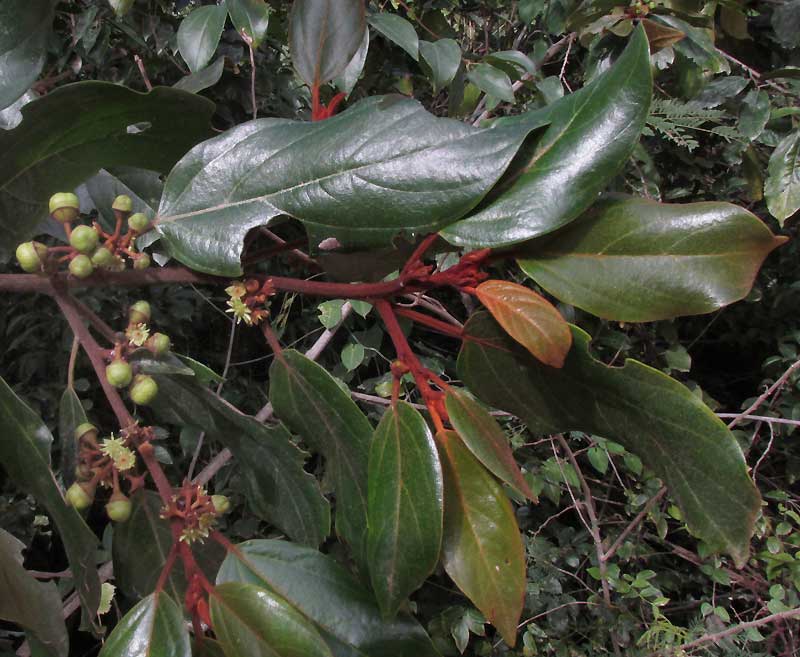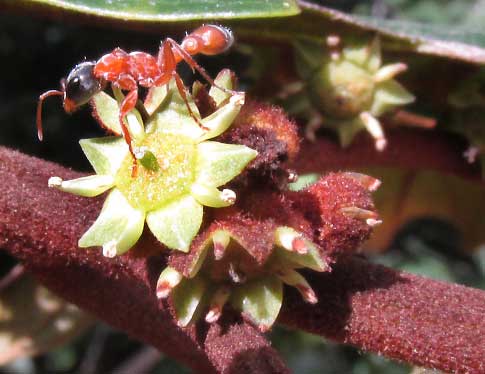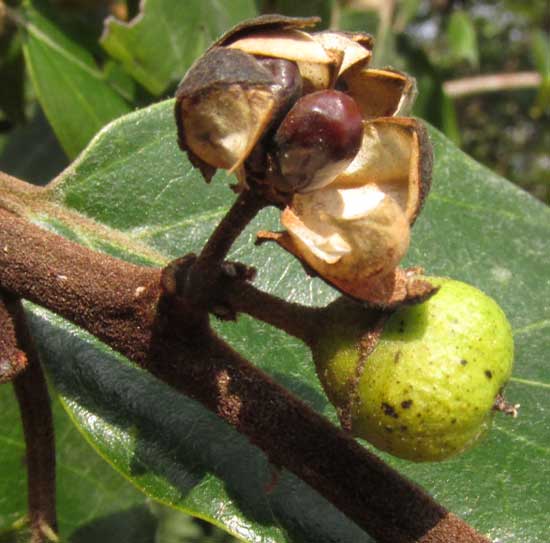Excerpts from Jim Conrad's
Naturalist Newsletter

from the January 31, 2016 Newsletter issued from Hacienda Chichen Resort beside Chichén Itzá Ruins; limestone bedrock; elevation ~39m (~128ft), N20.675°, W88.569°; central Yucatán state, MÉXICO
COFFEE COLUBRINA
At the edge of a narrow gravel road through the woods a woody shrub reached for sunlight, its leaves somewhat leathery and shiny on top, its stems densely covered with short, rusty-colored, velvety hairs, and greenish flowers and fruits, as seen above.
The flowers were of a type we've looked at before, but those species had different leaves and stems. A flower with a distinctive fleshy disc at its center, a green style emerging from the disc's middle, and with five stamens arising along the disc's perimeter is shown below:

 The shrub's immature capsular fruits are shown at the right.
The shrub's immature capsular fruits are shown at the right.
We've also seen fruits like that, with their bottoms invested with the former calyx. Both flowers and fruits are very similar to what we've identified as Nakedwood and Snakewood in the Yucatan, and Hog Plum in Texas -- Colubrina yucatanensis, Colubrina elliptica, and Colubrina texensis, respectively. Therefore, it was a good bet that this was yet a fourth species of the genus Colubrina, a member of the Buckthorn Family, the Rhamnaceae.
And it is, COLUBRINA ARBORESCENS, which here we'll call Coffee Colubrina. Other species of Colubrina also go by that name, plus they all share such names as Wild Coffee, Nakedwood, Snakebark, Geenheart, Colubrine, Blackbead, and such, so the English names with this group are more useless than usual.
Our Coffee Colubrina, Colubrina arborescens, occurs from southern Florida and the Bahamas south through the Caribbean and southern Mexico to Panama, plus, because of its handsome leaves and stems, it's planted in tropical zones beyond in many tropical lands.
Besides the flowers producing ample nectar, a service appreciated by the Yucatan's bee keepers, it's also used medicinally, in some places a tea being made from its leaves, and its wood being used against "rheumatism." Its wood is hard and heavy, fairly resistant to decay, and thus sought after for use as fence posts and, in the past, marine pilings.
On dry days when the fruits are ripe, the capsules pop open, flinging the seeds a short distance.
from the March 20, 2016 Newsletter issued from Hacienda Chichen Resort beside Chichén Itzá Ruins; limestone bedrock; elevation ~39m (~128ft), N20.675°, W88.569°; central Yucatán state, MÉXICO
COFFEE COLUBRINA FRUITING
Nowadays Coffee Colubrina's capsular fruits are splitting open here during the heart of the dry season, revealing hard, dark brown, shiny, bean-like seeds, as shown below:

A close-up showing a splitting fruit next to an immature fruit displaying the ringlike scar around the fruit's bottom, indicating where the sepals fell off, and serving as a good field mark for Colubrina, is shown below:

And a just-for-fun picture showing an ant emerging from behind a densely rusty-hairy leaf is shown below:
